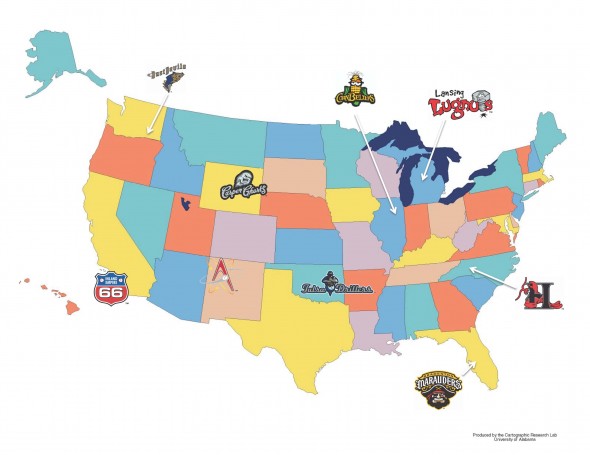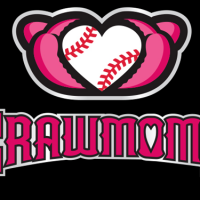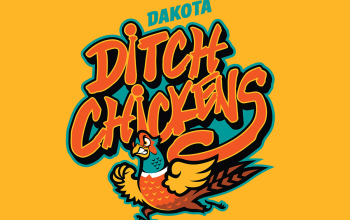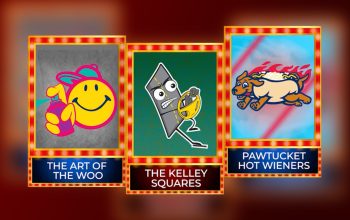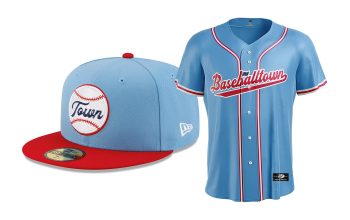Happy 4th of July to our American friends! Today we’d like to take you on a tour of the U.S by way of minor league baseball logos, making stops along the way in some of America’s biggest small towns! Now this isnt a “worst” or “best” list…some of these teams have stellar branding and some are, well….in severe need of a kick in the arse.
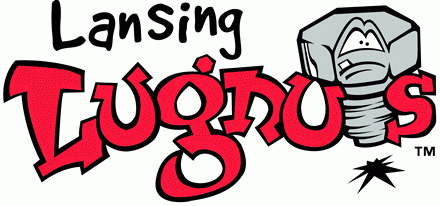
Lets start at the top of the map with our first stop…lets check out the Lansing Lugnuts –– What a place to start our tour of American minor league teams! The lugnuts boast one of minor league baseball’s most identifiable brands. The Lugnuts were first introduced to the Midwest league in 1996 and the team has been affiliated with the Toronto Blue Jays since 2005. The team moved from place to place over the years, starting in Lafayette Indiana in 1955 and making stops along the way in Waterloo Iowa and Springfield Illinois before settling in Lansing.
Lansing (the capital of Michigan for all those that dont know) is the fifth largest city in Michigan and is infamous for it’s ties to the automobile industry. Most of the modern city of Lansing is the direct the founding of Olds Motor Vehicle Company which was founded in August 1897. The city became a powerhouse in the industry. The Lugnuts name is a direct reference to the automobile part that secures a wheel to a vehicle. The logo for the team hasn’t changed since 1996 and is extremely popular with fans BUT they may want to think about adjusting the actual “lugnut” in the image to something more resembling an actual “lugnut”….just sayin’. Readers of Sportslogos.net give it a solid 5.4 stars. Uniquely, the Lugnuts have their own theme song which plays after the National anthem at every game.

Albuquerque Isotopes — The Isotopes had their inaugural season in Albuquerque in 2003 when the Calgary Cannons relocated to New Mexico. The Isotopes’ mascot is Orbit, a yellow, orange, and red alien and the team logo is a bold representation of and Isotope. Famously, the Isotopes name was chosen from an online survey of fans who picked the name that was first used as the fictional “Springfield Isotopes” from the TV series The Simpsons. In episode 263 (“Hungry, Hungry Homer”) Homer attempts to thwart the team’s plan to move to Albuquerque by going on a hunger strike. The Albuquerque Tribune’s online survey helped the team decide its new name, and “Isotopes” received 67 percent of the 120,000 votes.
After the team name was announced in September 2002, for three months even before the team ever took the field, they sold more merchandise than the Albuquerque Dukes sold in any single season. WOW! The power of branding. So why not head down to Isotopes Park soon to check out the team and while you’re in Albuquerque, don’t forget to take some pictures of the incredible Rio Grande and Sandia Mountains!
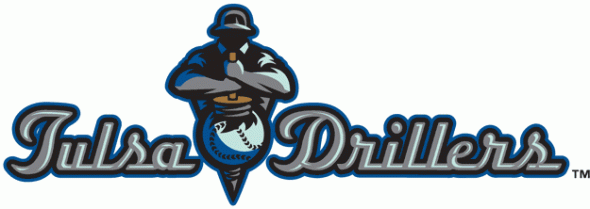
Tulsa Drillers – These Texas League heavyweights have the scariest logo going, featuring a very cross looking “driller” taking it to a baseball. The Drillers are the Double A affiliate of the Colorado Rockies and play in the tough Texas League in Tulsa Oklahoma. Nicknamed the “Oil Capital of the World” Tulsa was for most of the 20th Century a heavyweight in the American oil industry.
What is most fanastic about this team it it’s stellar ballpark. ONEOK Field is perfectly situated in the historic Greenwood District of downtown Tulsa and was officially opened on April 8, 2010. The 2012 Texas League All star game was played there and enjoyed a sell-out crowd. The art deco style architecture of the ballpark pays tribute to Tulsa’s professional baseball past, the Greenwood District and the City of Tulsa. So join the Drillers Monday July 9th for Bobblehead Hero night featuring star player Wilin Rosario (yes, thats his name). After the game, take in one of America’s most incredible cities. By the way, Tulsa claims to be the birthplace of Route 66….which leads us to our next destination!
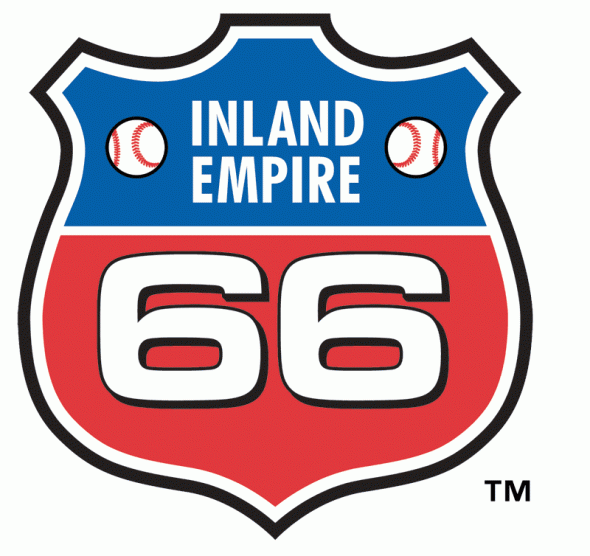
Inland Empire 66ers — The inland Empire 66ers of beautiful San Bernadino California are members of the California League and affliates of the Los Angeles Angels. Such great players ar Ken Griffey Jr. played for the team.The 66ers name pays tribute to historic U. S. Route 66 that ran straight through San Bernardino. Route 66, or “Main Street America” is known as the mother road. Originally built in 1926, the highway ran all the way from Chicago, Illinois, through Missouri, Kansas, Oklahoma, Texas, New Mexico, Arizona, and California, before ending at Los Angeles. The road became an iconic symbol of the exodus of people migrating West out of the Dust bowl in the 1930’s. Today the 66ers logo invokes the iconic roadside signs that have become such an important part of American culture. So check out the 66ers soon at San Manuel Stadium. But not tonight!!! THEY ARE SOLD OUT FOR THE FOURTH OF JULY!!!
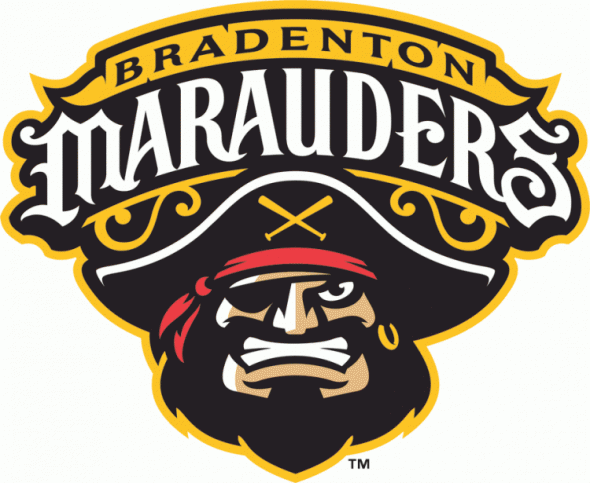
Bradenton Marauders – This class A-Advanced affiliate of the Pittsburg Pirates is no joke. Its branding strikes fear in the hearts of opponents. With gritted teeth, the popular pirate mascot of the Marauders shines on what is a really cool logo. The Marauders play at McKechni Field in Bradenton Florida, the home of Pirates Spring training. The area that would become Bradenton was famously explored in 1539 by Hernando De Soto, who began his search for the legendary El Dorado at Shaw’s Point. Now Bradenton is a thriving city and home to Tropicana Products, one of the biggest orange juice makers in the world.
The Marauders themselves were established in 1957 as the Tampa Tarpons and over the years hosted such famous players as Pete Rose. An interesting uniform note: On July 17, 1999, the Tampa Bay Devil Rays wore the 1960 Tarpons uniforms in a game against the New York Mets, who wore uniforms close of those worn by their 1969 championship team. The big story for the Marauders in their 2011 season hasn’t really been their play but more their attendance improvements. The Marauders drew 56,718 fans to their home games in 2011. Interestingly, the Mauraders introduced their new branding the same year. Anyone who’s been to Spring Training in Florida knows that it is as hot as the face of the sun. But if you’re up for it, take a swing by the ballpark on July 14 as the Marauders take on the Brevard County Manatees. Should be quite a match-up.
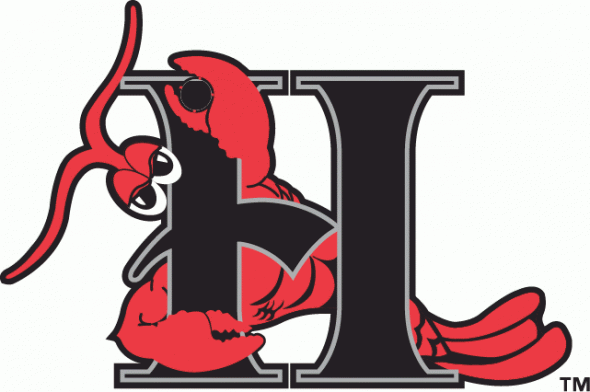
Hickory Crawdads – Now this has to be one of my favourite team names. The Hickory Crawdads are based in beautiful Hickory North Carolina. In the 1850s, under a huge Hickory Tree, Henry Robinson built a tavern of logs. The city of “Hickory Tavern” was established in 1863 and the name was eventually changed to “Hickory” in 1873. It was famous for it’s furniture manufacturing industry with many sturdy forests and skilled carpenters to be had in the late nineteenth and early 20th centuries.
The Crawdads have been farm team for the Texas Rangers and before that the Pittsburg Pirates and have played at L.P Frans Stadium since 1993. Notable alumni include Jose Bautista and Carlos Lee. The team’s mascot is “Conrad the Crawdad”, whose name was chosen during a contest that was held locally. So what the heck is a crawdad? Also known as a “crayfish” or “mudbug” this tiny crustacean is native to North Carolina rivers and can burrow up to three meters deep in the muck during winter. In case you’re interested, Conrad has a chick too…named “Candy Crawdad”…..creepy???? And if you’re in the area tonight, stop by for some Fourth of July Fireworks!
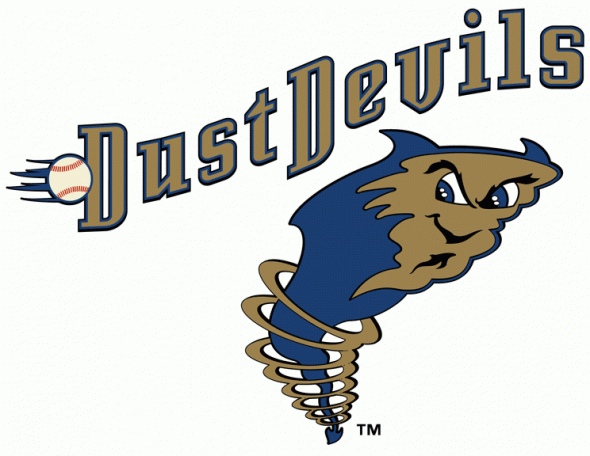
Tri City Dust Devils — Pasco Washington is home to the 3 time Northwest League Eastern Division Champions the Tri City Devils. Yesterday a record setting crowd attended at Gesa Stadium as the Devils sucessfully completed a sweep of the Boise Hawks with a 6-4 win. Since their inception in 2001 the Devils have been a farm team for the Colorado Rockies. Pasco is one of three cities that make up the Tri Cities region in Washington state. In 1805 the Lewis and Clarke expedition camped in Pasco, an area that was at the time frequented by fur trappers and gold traders. The Dust Devils have derived their name from the rain shadow cast on the city by the Cascade Range of mountains. The area is a windswept desert, with minimal precipitation throughout the year. Hot summers and cold winters provide a stark contrast to other areas of the state. Oooooh, so gloomy. The dust devils have had the same branding since 2001 and it really shows. The outdated logo features a (bearded?) dust cyclone with a nasty looking face. The colours and fonts are dated and the whole thing just seems so wrong. HOPEFULLY, we’ll get to see a rebrand soon. In the meantime, despite the problems with their look, this team could make it to the top again. Check them out this weekend when they take on the Spokane Indians at Home.
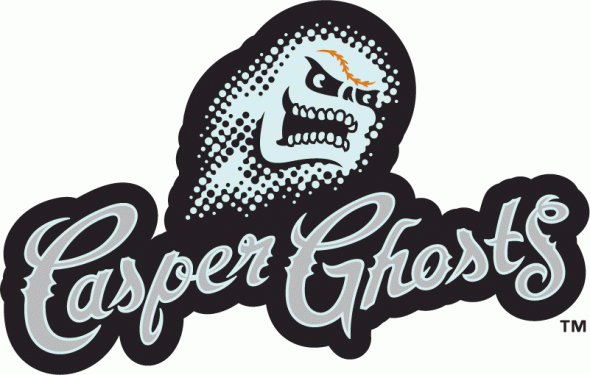
Casper Ghosts – The Pioneer League’s “Casper Ghosts” have been scaring up wins since 2001 (really bad joke, I couldn’t resist). From 2001 to 2007 they were known as the “Casper Rockies” and then changed their name in 2007 to the “Casper Ghosts”. They are the rookie affiliate of the Colorado Rockies and have hosted such famed major leaguers as Omar Vizquel and Cecil Fielder. Casper is Wyoming’s second largest city and is situated at the foot of Casper Mountain along the North Platte river. The mountain range is named for Lieutenant Caspar Collins in July 1865, who was famously killed near Platte Bridge Station by a group of Indian warriors. Three months later the garrison was renamed Fort Caspar after Lieutenant Collins. Sadly, the team name has nothing to do with this but rather makes reference to the popular cartoon “Casper the Friendly Ghost” . In 2007, the Casper Ghosts unveiled glow-in-the-dark hats, a first and only for the Pioneer League which featured their odd looking ghost mascot. But if you want to see the team in Casper, unfortunately you missed out. After 11 seasons, the team was moved to Grand Junction, Colo., and again will be called the Rockies, according to Executive Director Tim Ray. You can check them out at Sam Suplizio Field in Grand Junction all summer.
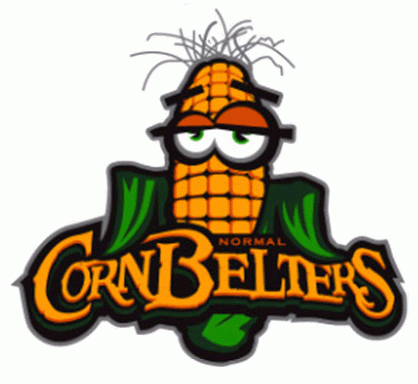
Normal CornBelters – Welcome to Normal Illinois, population 52,497! The CornBelters have been proud members of the Frontier League since May 2010 and for those of your that don’t know, Normal is located smack dab in the middle of what is known as the “Corn Belt” (or “Grain Belt”) of America. Since the 1850’s the Corn Belt has been pumping out corn crops like nobody’s business, helping to drive the nation’s rich agricultural economy. The Corn belt is famous for its intensely close communities and multi-generational family farms. What a great homage the CornBelters branding is to the strong bonds of this beautiful part of America. The logo for the team is just that, a homage to those hard working farmers and families working the Corn Belt. A lazy-eyed corn husk with mussed up hair make this logo fun and accessible. The team seems to markets heavily to kids and families so this logo is really perfect for that purpose. You can catch the CornBelters at their fantastic ballpark (lovingly called “The Corn Crib”) all this season. I would reccomend the July 19th – 21st homestand against my Frontier League team of choice, the London Rippers.
There is so much more to say about each of these places but we’d need days to cover it! Glad you took the trip with us and we hope you have a safe and happy Fourth of July!

